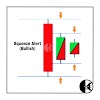Directional probability of every market.
By that I mean that if you don't even look at a chart and you buy any stock and then place a one cancels the other (OCO) order to exit on a profit-taking limit order X cents above your entry or on a protective stop at X cents below your entry, you have about a 50 percent chance of being right.
Likewise, if you sell any stock at any point in the day without looking at a chart and then place a profit-taking limit order X cents lower and a protective stop X cents higher, you have about a 50 percent chance of winning and about a 50 percent chance of losing . There is the obvious exception of X being too large relative the price of the stock.
You can't have X be $60 in a $50 stock, because you would have a 0 percent chance of losing $60. You also can't have X be $49, because the odds of losing $49 would also be minuscule. But if you pick a value for X that is within reasonable reach on your TF (time frame)
this is generally true. When the market is 50–50, it is uncertain and you cannot rationally have an opinion about its direction. This is the hallmark of a trading range, so whenever you are uncertain, assume that the market is in a trading range. There are brief times on a chart when the directional probability is higher.
During a strong trend, it might be 60% or even 70%, but that cannot last long because it will gravitate toward uncertainty and a 50–50 market where both the bulls and bears feel there is value. When there is a trend and some level of directional certainty, the market will also gravitate toward areas of support and resistance, which are usually some type of measured move away, and those areas are invariably where uncertainty returns and a trading range develops, at least briefly.









Post a Comment
0 Comments